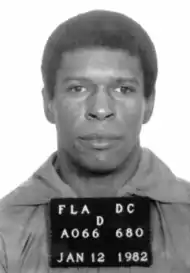Edward Dean Kennedy
Edward Dean Kennedy (May 25, 1945 – July 21, 1992) was an American murderer who was executed in 1992 by the state of Florida for the 1981 murders of state trooper Robert McDermon and McDermon's cousin Floyd Cone.[note 1] The killings occurred just hours after Kennedy escaped from the Union Correctional Institution, where he was serving a life sentence for a 1978 robbery-murder. Kennedy was convicted of the new murders, was sentenced to death, and was executed by the electric chair.[3][4]
Edward Dean Kennedy | |
|---|---|
 | |
| Born | May 25, 1945[1] |
| Died | July 21, 1992 (aged 47) |
| Cause of death | Execution by electrocution |
| Other names | "Sonny" |
| Criminal status | Executed |
| Conviction(s) | First degree murder (3 counts) |
| Criminal penalty | Death |
| Details | |
| Victims | 3 |
| Date | 1978 April 11, 1981 |
| Country | United States |
| State(s) | Florida |
Crimes
In 1978, Kennedy murdered a motel clerk during a robbery in Miami. He was apprehended, tried, but was able to sway the judge out of a death sentence by stating he wanted to do something good for society.[5] He was ultimately sentenced to life imprisonment, and was housed at the Union Correctional Institution.[2]
On April 11, 1981, Kennedy, along with two other inmates, escaped from the prison. The two men were quickly recaptured, while Kennedy remained at large.[6] During this time, Kennedy broke into a home where he stole multiple weapons, as well as changing clothes. At the same time, the home's owner, Floyd Cone, and Cone's cousin, Robert C. McDermon, a Florida Highway Trooper, entered the home. Kennedy then shot both men to death before fleeing, running to another house on the same block, holding the owner's hostage while police and other authorities surrounded the area. Kennedy exclaimed he wanted television news stations covering the events as he let the occupants free. He was arrested and taken into custody not long after.[6]
Trial
Kennedy was tried under an all-white jury on two counts of first degree murder, and was ultimately convicted and sentenced to death.[2] In 1984, Kennedy attempted to appeal his sentence, arguing his confession should not have been admissible in court, citing the state did not prove that he had knowingly provided his right to remain silent. Other arguments, including the excusing of a venireman, the admissibility of photographic evidence, and the propriety of certain jury instructions and of the prosecutor's closing argument were presented. In the end, the appeal was dismissed and Kennedy's death sentence was upheld.[6]
Execution
Kennedy was scheduled to die on February 11, 1986, at 7 a.m. along with convicted killer Paul B. Johnson, who was condemned for killing a deputy sheriff. However, a high court granted a stay of execution for Kennedy.[5]
The decision to execute Kennedy was argued upon, and on the day of his new scheduled execution, about a half-dozen people protested outside the prison. On July 21, 1992, after the supreme court refused a stay of execution, Kennedy was executed by the electric chair. His execution was the 29th in Florida since Capital punishment was reinstated in the United States.[3][4]
Notes
- One source lists his name as "Floyd Crane".[2]
References
- "Execution List: 1976 - present". Florida Department of Corrections. Retrieved March 9, 2022.
- "Kennedy executed for double killing". United Press International. July 21, 1992. Retrieved March 9, 2022.
- "Escapee Who Killed 2 Is Executed in Florida". The New York Times. July 22, 1992. Retrieved March 9, 2022.
- "Killer Of Three Executed in Florida's Electric Chair". Associated Press. July 21, 1992. Retrieved March 9, 2022.
- "STAY OF EXECUTION IS GRANTED TO CONVICTED KILLER OF 2 MEN". South Florida Sun-Sentinel. Associated Press. February 15, 1986. Retrieved March 9, 2022.
- "Kennedy v. State". Justia. Retrieved March 9, 2022.